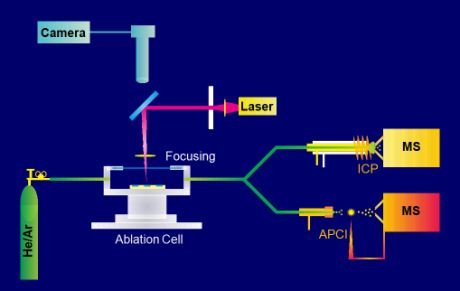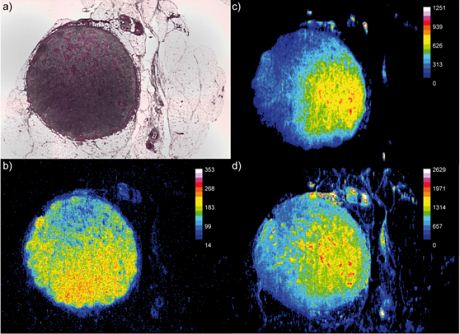Researchers from the University of Münster (Germany) now demonstrated the first simultaneous elemental and molecular MS imaging approach based on laser ablation sampling for spatially resolved speciation analysis. The dual hyphenated system combines the advantages of LA-ICP-MS such as low detection limits and high spatial resolution with information on the chemical identity and therefore can be used not only for localization of metals, but also for identification of metal species in biological samples.
Background:Laser ablation is a well established technique for sampling solid materials with spatial resolution. Coupled with a plasma source for atomic emission spectrometry (ICP-OES) or inorganic mass spectrometry (ICP-MS), this technique can be used for the spatially resolved determination of trace elements. More recently, LA-ICP-MS has been used very successfully for the imaging of trace metals in tissue sections providing even quantitative information. Trace metals play a very important role in biological systems, which is the topic of scientific investigations summarized under the heading "metallomics". However, biological functions of metals are not only specified by the element itself, but also by its chemical form and by its organ, cell and subcellular location. For this reason such investigations heavily benefit from a spatially resolved determination of species rather than elements in biological systems. Up to now, mainly two mass spectrometric techniques provide such information: namely matrix-assisted laser desorption ionization (MALDI) and secondary ion mass spectrometry (SIMS). Both techniques have some limitations: quantification is cumbersome or even impossible, since the sensitivity for each species depends both on the species but also on the matrix characteristics.
The new studies:
A group of researchers from the University of Münster now has combined the advantages of laser ablation for solid sampling with the possibilities of molecular mass spectrometry for species detection. The researchers coupled a commercially available UV laser ablation (LA) system with an atmospheric pressure chemical ionization (APCI) mass spectrometer. Using spatially resolved sampling by focusing the 213 nm laser beam onto a sample high resolution images of small molecules in native samples could be obtained. The fine aerosol generated by the ns pulsed laser irradiation was then transported to an APCI mass spectrometer with the aid of a transport gas stream (see lower part in the figure below). In the APCI source, post-ionization was accomplished by a corona discharge. The resulting ions were detected with an orbitrap mass spectrometer.

Figure 1: Schematic of the LA-ICP-MS/APCI-MS setup
The capabilities of this approach were demonstrated by spatially
resolved analysis of several samples including tablets, TLC plates and
dried droplets. The target compounds are detected with high spatial and
mass resolution. For higher molecular weight compounds like thyroxine,
fragmentation was observed, whereas small molecules like caffeine stayed
intact.
The researchers then combined the capabilities of molecular mass spectrometry for species identification with the capabilities of inorganic mass spectrometry for elemental quantification. To allow for spatially resolved analysis with simultaneous elemental and molecular information the laser ablation system was hyphenated in parallel both with an ICP-MS and an APCI-MS via flow splitted transfer lines to simultaneously obtain data from both spectrometers.
 Figure 2: Imaging MS of a lymph node: a) shows the optical Image, b) shows the image of m/z 27 (Al) obtained by LA/ICP-MS, c) shows the ion image for m/z 648.6978-648.7307 (eosin MH+) obtained by LA/APCI-MS, and d) shows the ion image of m/z 79 (Br) obtained by LA/ICP-MS.
Figure 2: Imaging MS of a lymph node: a) shows the optical Image, b) shows the image of m/z 27 (Al) obtained by LA/ICP-MS, c) shows the ion image for m/z 648.6978-648.7307 (eosin MH+) obtained by LA/APCI-MS, and d) shows the ion image of m/z 79 (Br) obtained by LA/ICP-MS.Using this approach, simultaneous elemental and molecular MS imaging with high spatial resolution down to 25 µm was obtained for the staining agents eosin Y and haematoxylin as well as for the chemotherapy drug cisplatin in thin tissue sections. For molecular MS, target compounds were identified by their exact masses and by characteristic fragment ions.
The researchers express their expectations that this novel technique opens up new possibilities to address complex challenges in life science research.
 The original studies
The original studies
Christina Herdering, Olga Reifschneider,
Christoph A. Wehe,
Michael Sperling,
Uwe Karst,
Ambient molecular imaging by laser ablation atmospheric pressure chemical ionization mass spectrometry, Rapid Commun. Mass Spectrom., 27 (2013) 2595–2600.
DOI: 10.1002/rcm.6727
Christina Herdering,
Christoph A. Wehe, Olga Reifschneider, Indra Raj, Giuliano Ciarimboli, Kurt Diebold, Christoph Becker,
Michael Sperling,
Uwe Karst,
Laser ablation based bioimaging with simultaneous elemental and molecular mass spectrometry: towards spatially resolved speciation analysis, Rapid Commun. Mass Spectrom., 27 (2013) 2588–2594.
DOI: 10.1002/rcm.6726 Used instrumentation:
Used instrumentation: CETAC: LSX-213 Laser ablation
CETAC: LSX-213 Laser ablation Thermo Scientific: iCAP-Q ICP-MS
Thermo Scientific: iCAP-Q ICP-MS Thermo Scientific: Exactive Orbitrap Mass Spectrometer
Thermo Scientific: Exactive Orbitrap Mass Spectrometer Related studies
Related studies
O. Reifschneider,
C. A. Wehe, K. Diebold, C. Becker,
M. Sperling,
U. Karst,
Elemental bioimaging of haematoxylin and eosin-stained tissues by laser ablation ICP-MS, J. Anal. At. Spectrom., 28 (2013) 989-993.
DOI: 10.1039/C3JA50046B
C.P. Wu, A.L. Dill, L.S. Eberlin, R.G. Cooks, D.R. Ifa,
Mass spectrometry imaging under ambient conditions, Mass Spectrom. Rev., 32 (2013) 218-243.
doi: 10.1002/mas.21360
A. Römpp, B. Spengler,
Mass spectrometry imaging with high resolution in mass and space, Histochem. Cell Biol., 139 (2013) 759.
DOI: 10.1007/s00418-013-1097-6
D. Hare, C. Austin, P. Doble,
Quantification strategies for elemental imaging of biological samples using laser ablation-inductively coupled plasma-mass spectrometry, Analyst, 137 (2012) 1527-1537.
DOI: 10.1039/C2AN15792F
J. Koch, D. Günther,
Review of the state-of-the-art of laser ablation inductively coupled plasma mass spectrometry, Appl. Spectrosc., 65 (2011) 155A-162A.
DOI: 10.1366/11-06255. J.S. Becker
J.S. Becker, M. Zoriy, A. Matusch, B. Wu, D. Salber, C. Palm, J.S. Becker,
Bioimaging of metals by laser ablation inductively coupled plasma mass spectrometry (LA-ICP-MS), Mass Spectrom. Rev., 29 (2010) 156-175.
DOI:10.1002/mas.20239 
J. Pól, M. Strohalm, V. Havlíèek, M. Volny,
Molecular mass spectrometry imaging in biomedical and life science research, Histochem. Cell Biol., 134 (2010) 423-.
DOI: 10.1007/s00418-010-0753-3
J.T. Shelley, S.J. Ray,
G.M. Hieftje,
Laser ablation coupled to a flowing atmospheric pressure afterglow for ambient mass spectral imaging, Anal. Chem., 80 (2008) 8308-8313.
doi: 10.1021/ac801594u
M. Wind, W. D. Lehmann,
Element and molecular mass spectrometry - an emerging analytical dream team in the life sciences, J. Anal. At. Spectrom., 19 (2004) 20-25.
DOI: 10.1039/b309482k Related EVISA Resources
Related EVISA Resources Instrument database: Laser ablation systems
Instrument database: Laser ablation systems Instrument database: ICP-MS instruments
Instrument database: ICP-MS instruments Instrument database: ESI/APCI-MS Spectrometers
Instrument database: ESI/APCI-MS Spectrometers  Related information
Related information COST: MS Imaging
COST: MS ImagingThis site is dedicated to sharing information on matrix-assisted laser
desorption/ionization mass spectrometric imaging (MALDI MSI, also termed
imaging MS or MS imaging)
 ESMI: European Society for Molecular Imaging
ESMI: European Society for Molecular ImagingESMI is an independent scientific society providing an interdisciplinary platform for knowledge exchange in the field of Molecular Imaging covering basic biomedical, preclinical and clinical imaging science
 imzML - a common data format for MS imaging
imzML - a common data format for MS imagingThe purpose of imzML is to facilitate the exchange and processing of
mass spectrometry imaging data. This website is intended to provide all
information neccesary to implement imzML.
 maldi-msi.org: Software tools for imaging mass spectrometry
maldi-msi.org: Software tools for imaging mass spectrometry MSiReader — vendor neutral MS Imaging Software
MSiReader — vendor neutral MS Imaging SoftwareMSiReader is a vendor-neutral interface built on the Matlab platform
designed to view and perform data analysis of Mass Spectrometry Imaging
(MSI) data.
 OpenMSI
OpenMSIAdvanced visualization, analysis and management of mass spectrometry imaging data via the web
 World Molecular Imaging Society
World Molecular Imaging Society WMIS is an international scientific educational organization dedicated to
the understanding of biology and medicine through multimodal
in vivo
imaging of cellular and molecular events involved in normal and
pathologic processes and utilization of quantitative molecular imaging
in patient care.
 Related EVISA News
Related EVISA News July 25, 2013: Thermo Fisher Scientific Wins Five R&D 100 Awards
July 25, 2013: Thermo Fisher Scientific Wins Five R&D 100 Awards July 17, 2013: Agilent Technologies Triple Quadrupole ICP-MS Selected for R&D 100 Award
July 17, 2013: Agilent Technologies Triple Quadrupole ICP-MS Selected for R&D 100 Award February 11, 2013: Bruker launched its new aurora Elite ICP-MS instrument with spectacular sensitivity specs
February 11, 2013: Bruker launched its new aurora Elite ICP-MS instrument with spectacular sensitivity specs  July 19, 2012: Triple Quad ICP-MS: Pushing the limits for quantitation of phosphorus and sulfur
July 19, 2012: Triple Quad ICP-MS: Pushing the limits for quantitation of phosphorus and sulfur
last time modified: November 28, 2013